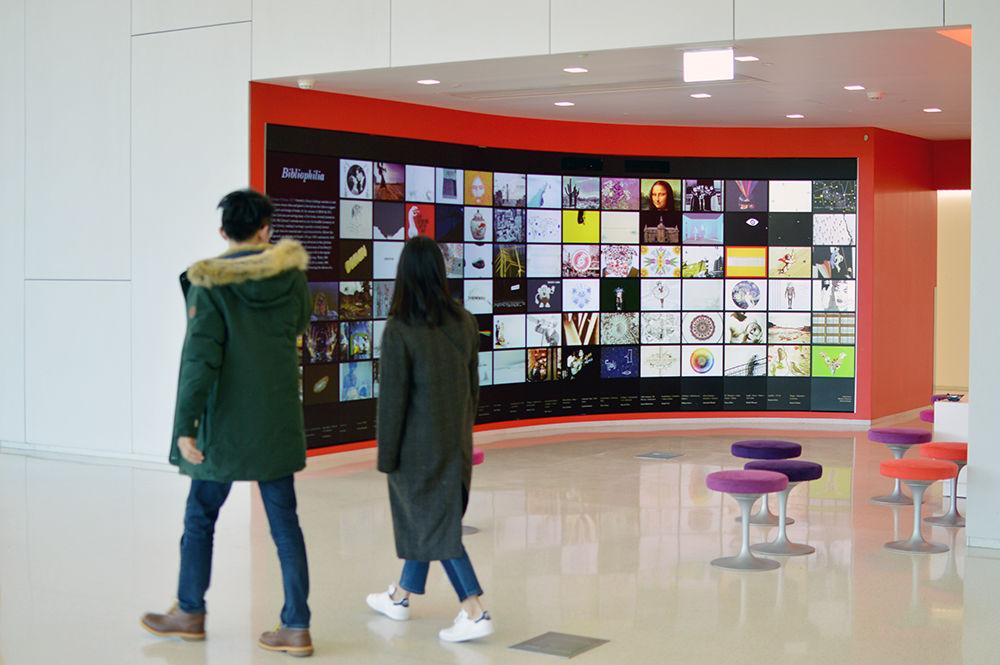When one thinks of art, images of pottery, sculptures and pristine galleries filled with framed pieces created by way of colorful watercolor or acrylic paints typically come to mind. However, there lies a special relationship between technology and art that is often left behind. Hunt Library is changing that. From 90 animated GIFs to hand-drawn illustrations of wild animals, this year’s Fall Student Showcase is displaying various student and class projects on Hunt Library’s four video walls — which amount to roughly 800 square feet of pixel space. The exhibit will run until Wednesday during normal library hours.
Every semester, creative media from independent student projects, classes and/or student groups are shown at the showcase, which aims at displaying the best digital media material compiled throughout the semester. Mike Nutt, director of visualization services at NCSU Libraries, works to ensure the video walls are optimized to their fullest potential.
“One of the things we hope to do with the video walls at Hunt is to showcase the work that the campus is doing, and to make those screens a platform to tell the stories of what’s happening on campus,” Nutt said.
The Fall Student Showcase acts as a way for students to do just that, sharing stories that may not have otherwise been told. Each semester, NCSU Libraries does outreach with faculty whose classes may benefit from showing their work on the video walls, and it is not uncommon for students and NCSU Libraries student employees to take initiative in reserving a space to display creative endeavors of their very own.
For student artists of all varieties, the video walls offer a one-of-a-kind chance to show their work on a medium that is in a class all by itself.
“Not everybody gets to design for a 20-foot-wide canvas in a library,” Nutt said. “So, I feel like when students get to create content for those video walls it’s a really unique opportunity that not a lot of other people have and hopefully that helps them stand out in whatever they do after college.”
The collision of code and art, or creative coding, is a field that Nutt claims is ever growing in nature, just like its existence here at NC State. From events like last year’s Code Art Contest which featured artful submission, to this year’s Creative Coding event that took place at the Gregg Museum of Art and Design, it’s clear the unlikely partnership between art and code is the future, and its artists the innovators.
For Nutt, one of the most rewarding parts about watching creative coding boom is its ability to open doors for students who have a passion for both coding and an insatiable creative desire.
“If we can give students a venue to showcase some of the things that they’re creating in their work or an additional venue outside of their college, so that more people can see it, then I think that’s a really valuable thing for librarians to do,” Nutt said.
Maria Gallardo-Williams, teaching associate professor in the Department of Chemistry and director of Undergraduate Organic Laboratories, was able to show her organic chemistry students’ work at this year’s showcase.
In order to bring to light the more creative side of chemistry — which Gallardo-Williams said often has a negative, stuffy reputation as a field — Gallardo-Williams asked her students to create a physical representation of a chemical compound of their choice. An assignment full of endless creative possibilities resulted in a diverse line-up of submissions, which were then documented on social media; the projects that got the most hits online were then chosen to be displayed at the student showcase.
“I honestly couldn’t pick a favorite [project],” Gallardo-Williams said. “There’s a lot of projects where the students are very creative in their use of material. The material that you use to 3-D print things is a polymer, so one of our students recreated polymer by making 3D-printed earrings.”
Impressively designed coasters made from ethanol proved another popular hit on social media, which was then showcased in the digital space but, for Gallardo-Williams, simply seeing her students’ work on display in the space was a feat worth celebrating — and one she encourages others to emulate.
“If you have anything that can be portrayed in a visual way, it’s a great way to reach a lot people,” Gallardo-Williams said.













